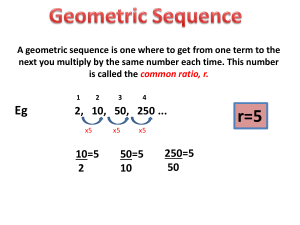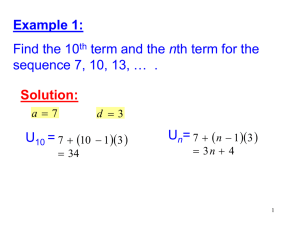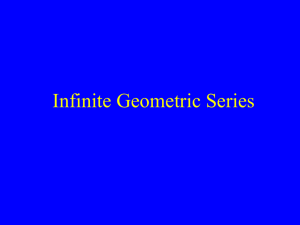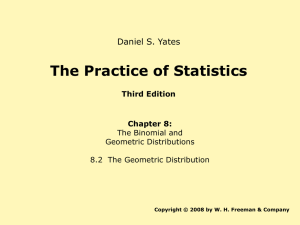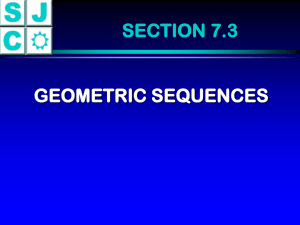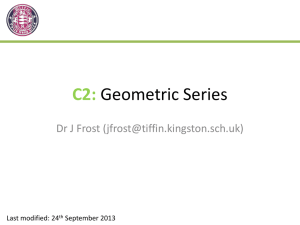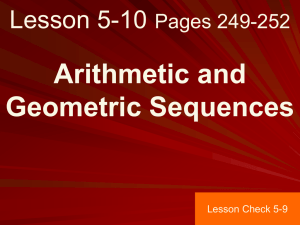Geometric Progression: Formulas, Examples & Exercises
advertisement
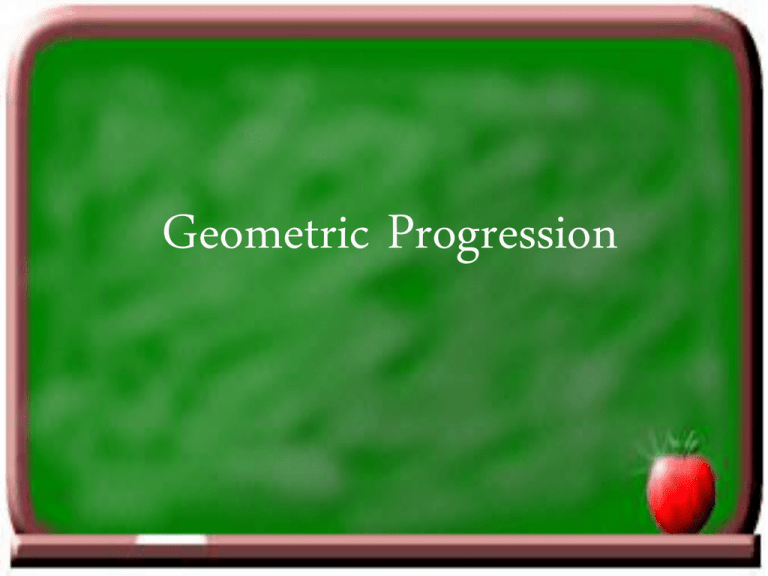
Geometric Progression Objectives The presentation intends to: teach students how to solve problems related to geometric progressions; help students understand more about the given topic; What are geometric progressions? It is a sequence in which each term is obtained by multiplying the preceding term by a constant A sequence t1,t2, . . . . tn, . . . is called a geometric sequence ( or more commonly a geometric progression) if there exists a number r such that tn/tn-1 = r for n>1 Also known as a geometric sequence, is a sequence of numbers where each term after the first is found by multiplying the previous one by a fixed non-zero number called the common ratio. Symbols tn= last term n= number of terms r= common ratio a= first term Sn= sum of terms Formulas n-1 ar • tn= • a= tn/rn-1 n • Sn= a(1-r )/1-r • r= tn/tn-1 Examples Find the common ratio and general term of Geometric Progression 1) 1, 2/3, 4/9,… 2) 2,-4, 8,… r= 2/3 r= -4/ 2 1 = -2 =2/3 tn= 2(-2)n-1 tn= (2/3)n-1 3) √2, √6, 3√2,… 4) If x+3, 4x, 2x+18, form geometric progression, find x. r= √6 4x = 2x+18 √2 x+3 4x =√3 2= 2x2+6x+18x+54 n-1 16x tn=√2(√3) 14x2-24x-54=0 2 7x2-12x-27=0 (7x+9)(x-3)=0 x= -9 x=3 7 5) The fifth term of a geometric progression is 81 and the ninth term is 16. Find the first term, common ratio, and the nth term. t5= 81, t9=16, a=?, r=?, nth term= ? tn=arn-1 t5= ar5-1 t9= t5r9-5 81=a(2/3)4 16= 81r4 6561/16 81 tn=arn-1 4√16 = 2 tn = 6561/16(2/3)n-1 4√81 3 Insert three positive geometric means between a)1/2 and 128 ½, t2, t3, t4, 128 t5= ar5-1 128= ½ r4 ½ 256= r4 4 √r4=4 √256 r=4 t2=1/2(4)=2 t3=2(4)= 8 t4=8(4)= 32 b)1 and 4 1, t2, t3,t4, t5= ar5-1 4= 1r4 4 √r4=4 √4 r= 4√22 r= 2 2/4 r= 2 ½ r= √2 t2= 1 √2 t3= (√2) (√2) = 2 t4= 2 (√2) = 2√2 Find the sum of the first ten terms: 2+4+8+16+… Sn= a(1-rn) 1-r S10= 2[1-(2)10] 1-2 S10= 2(1-1624) -1 S10= 2046 Find the sum of the geometric progression 10, -2, 2/5,… to 8 terms Sn= a(1-rn) 1-r S8= 10[1-(-1/5)8] 1-(-1/5) S8= 10(1-0.00000256) 1.2 S8= 8.33 Find the t5of the geometric progression whose first element is -3 and whose common ratio is -2. tn= arn-1 t5= (-3)(-2)5-1 t5= (-3)(-2)4 t5= (-3)(16) t5= -48 Infinite Arithmetic and Geometric Progression Definition The sum of an infinite geometric progression a, ar, ar2, … with r < 1 is given by, S=a/1-r whereas, -1<r<1 S is also called the sum to infinity of the G.P. a, ar, ar2 … In symbols, we write this as, S=lim Sn and read “S is the limit of Sn as n increases without bound” The rational number 1/3 has repeating decimal .33333… which we can consider to be as infinite sum: 1/3 = .3+.03+.003+.0003+… This is an example of an infinite geometric series with ratio .1. Thus, .03 = .3x.1, .003 = .03x.1,.0003 = .0003x.1, and so on. We define an infinite geometric series in the following way. Find the sum of the following terms. 1) 1+2+3+4+5… 3) 9+3+1/3… =infinite r=1/3 S= a 2) 2+4+6+8… 1-r =infinite S= 9 1-1/3 S= 9 2/3 S= 27/2 4) 50+25+25/2… r=1/2 S= a 1-r S= 50 1-1/2 S= 50 1/2 S= 100 Exercises: A. Determine whether the sequence is a geometric progression or not. If the sequence is a geometric progression give the common ratio (r) and the next three terms. 1) 12,22,32 2) 1, -1/2, 1/3 3) 1/6, 1/2, 3/2 4) 4, 3, 9/4 5) 3, 3√3, 9 6) 2, √3, 2/3 7) 3.33, 2.22, 1.11 8) -36, -2, -1/9 B. Find the indicated term of the geometric progression whose first element is a and whose common ratio is r. a= ½ , r= 2/3, find t4 a= 4 , r=-1/2 , find t5 a= 81, r= 1/3, find t7 a= 1/3 , r= 3/2, find t6 C. Find the sum to the infinity of the geometric progression. 1. 2. 3. 4. 5. 16, 4, 1 ½, 1/6, 1/18 -2, -1/2, -1/8 2/3, 1/9, 1/54 5.05, 1.212, 0.29088 1. Insert five geometric means between a. 1/2 and 32 b. 2 and 54 E. For the specific value of n, find the nth term of each geometric series which starts as follows. 1. (a) 2+6+18+…, n = 7 (b) 5+10+20+…, n = 9 2. (a) 4+2+1+…, n = 8 (b) 25-5+1+…, n = 6 Solutions and Answers A. 1) 12,22,32 Not geometric progression 2) 1, -1/2, 1/3 Not geometric progression 3) 1/6, 1/2, 3/2 r=1/2 = 3 1/ 6 3 ( /2)(3)= 9/2 (9/2)(3)=27/2 (27/2)(3)= 81/2 next terms are 9/2,,27/2, 81/2 4) 4, 3, 9/4 r= 3/4 (3/4)(9/4)= 27/16 (3/4)(27/16)= 81/64 (3/4)(81/64)= 243/256 next terms are: 27/16, 81/64, 243/256 5) 3, 3√3, 9 r= √3 (√3)(9)= 9√3 (√3) (9√3)= 27 (√3)(27)=27√3 next terms are: 9√3, 27, 27√3 6) 2, √3, 2/3 Not geometric progression 7) 3.33, 2.22, 1.11 Not geometric progression 8) -36, -2, -1/9 r= -2/-36= 1/18 (-1/9)(1/18)= -1/162 (-1/162)(1/18)= -1/2916 (-1/2916)(1/18)= -1/52488 next terms are: -1/162, -1/2916, -1/52488 B. 1) a= ½ , r= 2/3, t4= ? tn= arn-1 t4= (½)(2/3)4-1 t4= (½)(2/3)3 t4= (½)(8/27) t4= 4/27 2) a= 4, r=-1/2 , t5= ? tn= arn-1 t5= (4)(-1/2)5-1 t5= (4)(-1/2)4 t5= (4)(1/16) t5= 4/16 t5= ¼ 3) a= 81, r= 1/3, t7=? tn= arn-1 t7= (81)(1/3)7-1 t7= (81)(1/3)6 t7= (81)(1/729) t7= 1/9 4) a= 1/3 , r= 3/2, t6=? tn= arn-1 t6= (1/3)(3/2)6-1 t6= (1/3)(3/2)5 t6= (1/3)(7 19/32) t6= 2 17/32 C. 1) 16, 4, 1 r=1/4 S= a 1-r S= 16 1-1/4 S= 16 3/ 4 S= 64/3 2) ½, 1/6, 1/18 r= 1/3 S= a 1-r S= ½ 1-1/3 S= ½ 2/3 S= 3/4 3) -2, -1/2, -1/8 r= ¼ S= a 1-r S= -2 1-1/4 S= -2 3/ 4 S= -8/3 4) 2/3, 1/9, 1/54 r= 1/6 S= a 1-r S= 2/3 1-1/6 S= 2/3 5/6 S= 4/5 5) 5.05, 1.212, 0.29088 r= 0.24 S= a 1-r S= 5.05 1-0.24 S= 5.05 0.76 S= 6 49/76 a. 1/2 and 32 t7=t1r6 32= ½ r6 32= ½ r6 ½ 64= r6 6√64=r r=2 t2 =1 t3=2 t4=4 t5=8 t6=16 b. 2 and 54 t7= t1r6 54=2r6 2 2 6 √27= 6 √ r6 r= 6 √27 r= 6 √33 r= √3 t2= 2 √3 t3= 6 t4= 6 √3 t5= 18 t6= 18 √3 E. 1. (a) 2+6+18+…,,n=7 tn= arn-1 t7= (2)(3)6 =1458 (b) 5+10+20+…, n=9 tn= arn-1 t9= (5)(2)8 = 1280 2. (a)4+2+1+…,n=8 tn=arn-1 t7=(4)(1/2)7 =1/32 (b) 25-5+1…,n=6 tn= arn-1 t6=(25)(-1/5)5 = -1/125 Prepared by: Princess Fernandez Karen Calanasan Kyla Villegas

